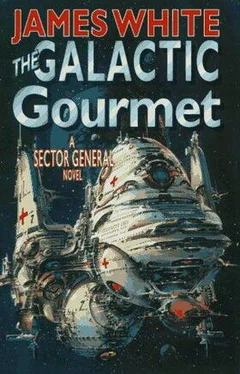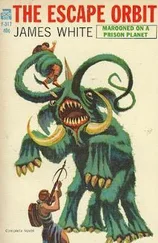He did not, however, have to travel very far,
“I–I don’t understand,” Gurronsevas protested. “This is a ship. A small, powered-down, empty ship, judging by the silence, the poor lighting, and this isn’t passenger accommodation. Where am I? What am I supposed to do here?”
“As you can now see,” Lioren said, switching on lights as it spoke, “you are on the casualty deck of the special ambulance ship Rhabwar, and you are to wait, patiently and very quietly, for its departure. While you are doing that the small number of people who know your whereabouts will be able to say, with the minimum of moral discomfort, that you are no longer in the hospital because, technically, this will be the truth.
“Being a Tralthan,” it went on, “you are accustomed to sleeping on your feet and will be physically comfortable here. Do not try to explore. Apart from this level, the ship was designed for operation by Earth-humans or other beings of similar or lesser body mass. Its officers and medical team will behave much more pleasantly towards you if you do not damage the structure and equipment.
“The casualty deck’s food dispenser is there,” it went on, pointing, “and the nursing station console, which is over there, will enable you to call up all the information you could possibly need about Rhabwar. Study it well before departure. You can call up the training and education channels if you are bored, but do not use the communicator because officially you are not here. Do nothing to attract attention. Don’t leave the ship, however briefly, or show yourself in the boarding tube or access corridor. I will visit you as often as possible.”
“Please,” said Gurronsevas. “Am I some kind of stowaway? Does the crew know I’m here? And how long must I wait?”
Lioren paused inside the lock chamber. It said, “I have no information regarding your shipboard status. Rhabwar’s medical team knows you are here, but the ship’s officers do not, so you must not reveal your presence to them until after the first hyperspace jump. I don’t know how long you will have to wait. Five days, according to one rumor I’ve heard, perhaps longer. The people concerned are having trouble making up their minds. If I find out for certain, I’ll tell you at once.”
Lioren disappeared into the boarding tube before Gurronsevas could think of another question.
He waited for a moment until the confusion in his mind had settled into curiosity and, moving carefully and placing his feet on nothing less solid than the deck, began investigating his surroundings.
Each one of the compartment’s walls was pierced by a large direct-vision panel. One showed a featureless expanse of metal which was probably the hospital’s outer hull, another a section of the docking cradle, and the other two looked out across the dazzling, white plains of Rhabwar’s delta wings. From the wall areas around and between the viewports projected equipment whose purpose would have been a total mystery to him even if it had been properly illuminated. In the center of the floor and ceiling were the circular openings to the communications well that gave access to the decks forward and aft. It was fitted with a multi-species ladder but was too narrow for a Tralthan.
The console that Lioren had indicated was surrounded by a mass of what appeared to be inactive medical monitoring equipment. He was still feeling too confused and ignorant to think constructively, so he called up the hospital’s main library, keying for a Tralthan printed translation with spoken backup, and asked for the available information on the ambulance ship Rhabwar.
The console screen lit with a message that was repeated from the speaker unit in a condescending voice. “Information is available on this subject without restriction,” it said. “Please specify precise requirements or choose from the following options: Ship design philosophy. Structural layout. Engineering and medical systems, sub-systems and equipment. Operating power reserves and mission duration. Crew and medical personnel specialties. Medical log of previous missions. Non-technical summary.”
Gurronsevas felt like an uneducated child as he chose the last item on the menu. But as the screen and the speaker began to present their information, his feelings changed rapidly to those of surprise and wonder because the summary began with a history lesson, an illustrated discussion on the formation and evolution of what had become the present Galactic Federation, from a philosophical viewpoint that was completely new to him.
On the screen there appeared, small but diamond-sharp, a three-dimensional representation of the galactic double spiral, with its major stellar features and the edge of a neighboring galaxy, shown at distances that were not to scale. As he listened, a short, bright line of yellow light appeared near the rim, then another and another — the links between Earth and the early Earth-seeded colonies, and the systems of Orligia and Nidia, which were the first extra-terrestrial cultures to be contacted. Another cluster of yellow lines appeared showing the worlds colonized or contacted by Traltha.
Several decades were to pass before the worlds available to the Orligians, Nidians, Tralthans and Earth-humans were made available to each other. In those days, the precise, emotionless voice explained, intelligent life-forms still tended to be suspicious and distrustful of each other — in one case, the early contacts between Orligia and Earth, to the point of declaring the first and so far only interstellar war. But time as well as distance was being compressed in the summary.
The tracery of gold lines grew more rapidly as contact, then commerce, was established with the highly advanced and stable cultures of Kelgia, Illensa, Hudlar, Melf and their associated colonies. Visually it was not an orderly progression. The lines darted inwards to the galactic center, doubled back to the rim, seesawed between zenith and nadir, and even made a jump across inter-galactic space to link up with the Ian worlds — although in that instance it had been the Ians who had done the initial traveling. When finally the lines connected the member worlds of the Galactic Federation, the result was an untidy yellow scribble resembling a cross between a DNA molecule and a child’s drawing of a bramble bush.
Provided the exact coordinates of the destination world were known, it was as easy to travel through subspace to a neighboring solar system as to one at the other side of the Galaxy. But one first had to find an inhabited planet before its coordinates could be logged, and that was proving to be no easy task.
Very, very slowly a few of the blank areas in the star charts were being mapped and surveyed, but with disappointing results. When the Monitor Corps scoutships discovered a star with planets, it was a rare find — even rarer when the planets included one that harbored life. And if one of the native life-forms was intelligent, jubilation — tempered with a natural concern over what might become a threat to the Pax Galactica — swept the worlds of the Federation. It was then that the Cultural Contact specialists of the Monitor Corps were sent to perform the tricky, time-consuming and often dangerous job of establishing contact in depth.
On the screen appeared a succession of tabulations giving details of the survey operations mounted, the number of ships and personnel involved and a cost figure that had too many digits to be credible. The voice went on, “During the past twenty years they have initiated First Contact procedures on three occasions, all of which resulted in the species concerned being accepted into the Federation. Within the same time period, Sector Twelve General Hospital became fully operational and also initiated First Contacts which resulted in seven new species joining the Federation.
Читать дальше

![Гарри Гаррисон - Bill, the Galactic Hero [= The Starsloggers]](/books/87536/garri-garrison-bill-the-galactic-hero-the-star-thumb.webp)










